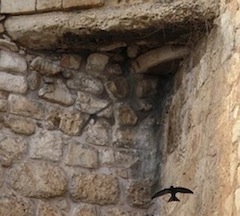|
|
|
|
 |
|
Swifts: symbols of Green Pilgrimage
This page has not been updated since June 2014.
At the Green Pilgrimage Network meeting in Trondheim, July 2013, the Network adopted the swift as a symbol of Green Pilgrimage. Noting that it was approaching the time when the migrating birds would be leaving Europe for their winter stay in the sky over Africa Alison Hilliard, ARC Deputy Secretary General, said that "Swifts are wonderful examples of the everyday miracles of travel and journeys. And powerful reminders of our connection with and responsibility for nature, creation and each other."
Every year in the springtime great flocks of swifts are welcomed with a ceremony in Jerusalem where they nest in the brickwork of many holy places, including mosques, churches and the sacred Western Wall. The birds remain in the city until their nestlings have fledged and then return to Africa in June.
This special meditation on swifts was prepared for the Trondheim GPN meeting:
Meditation on the pilgrimage of the swifts
 |
 |
 |
Swifts nesting in the Western Wall, Jerusalem |
You travel thousands of miles from the south of Africa through the holy places of our faiths to bring up your young here in the north. You travel hundreds even a thousand miles in a day or two to find food for your young. In a new prayer designed to be used by all faiths, we pray together:
May God be a smooth way before you,
May He be a guiding star above you,
A keen eye behind you,
This day, this night, forever.
When you leave the nest you do not touch the earth again for two years. You even sleep on the wing.
May God be the sustainer of life for you,
Be at peace with you,
be a support to you on the wing,
Be a star to you,
A helm to guide you,
From the day you first fly,
To the day you land here again.
You are faithful to your mate for life, yet you do not need to be together all the time. You travel secure in the fidelity of your love for one another.
As you leave us to travel onwards again,
Secure in the love you know,
In the love of God,
Remind us to also trust in God
And to travel through life knowing that we have a Guide
Travel through life knowing there is a Way,
Knowing we too are not alone.
As pilgrims of the air, the swifts are in danger from us at almost every stage. Together let us commit ourselves and our communities to protect our fellow pilgrims, and to protect all creation in its pilgrimage here on earth.
Read more about the Jerusalem celebrations for the swifts here.
Click here for Holy Birds of the Heavens - an article about swifts written by journalist and broadcaster Mary Colwell for The Tablet, a Catholic magazine.
Find out about Swift Conservation here.
|
 |
|
|
|
|
|
 |
March 28, 2012:
Jerusalem welcomes swifts to the Western Wall
The welcoming of swifts back to the Western Wall has become a ceremony that is held in Jerusalem every springtime. Jerusalem is one of the members of the Green Pilgrimage Network, and this is part of the movement to protect all nature, through thoughtful stewardship, gentle policies, and vigorous campaigning for improvements for all creation. |
 |
July 29, 2013:
Green Pilgrimage Network more than doubles to 28 members
At an extraordinary meeting in Trondheim this weekend 16 important pilgrim cities and places – including Santiago de Compostela, Bethlehem, Rishikesh, Varanasi and Mexico City – committed to become greener. |
 |
How does ARC work with the faiths?
We list some of the far-reaching ways that faiths can affect their environment |
 |
 |
|
|

